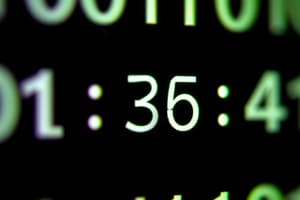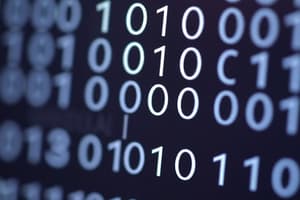Podcast
Questions and Answers
What is the first step in converting a decimal number to binary?
What is the first step in converting a decimal number to binary?
- Divide the decimal number by 2. (correct)
- Write down the decimal number as it is.
- Add 1 to the decimal number.
- Multiply the decimal number by 2.
How do you obtain the binary equivalent after calculating the remainders?
How do you obtain the binary equivalent after calculating the remainders?
- Arrange the remainders in the same order they were obtained.
- Arrange the remainders in ascending order.
- Write the remainders in reverse order. (correct)
- Add all the remainders together.
Which of the following is a valid representation for the decimal number 657 in binary?
Which of the following is a valid representation for the decimal number 657 in binary?
- 1010010001 (correct)
- 1011010110
- 0110101001
- 1101011001
What base does the octal number system use?
What base does the octal number system use?
In the binary multiplication table, what is the result of 1 multiplied by 1?
In the binary multiplication table, what is the result of 1 multiplied by 1?
What symbols are used in the hexadecimal number system?
What symbols are used in the hexadecimal number system?
Which decimal number is equivalent to the hexadecimal symbol 'C'?
Which decimal number is equivalent to the hexadecimal symbol 'C'?
When converting the decimal number 987 to binary, what is the last remainder obtained?
When converting the decimal number 987 to binary, what is the last remainder obtained?
What is the decimal equivalent of the binary number (1011)2?
What is the decimal equivalent of the binary number (1011)2?
What is the decimal equivalent of the binary number (100110)2?
What is the decimal equivalent of the binary number (100110)2?
When adding the binary numbers (10101)2 and (00111)2, what is the result?
When adding the binary numbers (10101)2 and (00111)2, what is the result?
What is the result of subtracting the binary number (01010)2 from (10011)2?
What is the result of subtracting the binary number (01010)2 from (10011)2?
What is the product of the binary numbers (101)2 and (011)2?
What is the product of the binary numbers (101)2 and (011)2?
What is the result of multiplying (1011)2 by (101)2?
What is the result of multiplying (1011)2 by (101)2?
What is the decimal equivalent of the binary number (10101)2?
What is the decimal equivalent of the binary number (10101)2?
What is the outcome of subtracting (001)2 from (111)2?
What is the outcome of subtracting (001)2 from (111)2?
What is the base of the Binary number system?
What is the base of the Binary number system?
Which digits are used in the Hexadecimal number system?
Which digits are used in the Hexadecimal number system?
In Binary subtraction, what is the result of 1 - 1?
In Binary subtraction, what is the result of 1 - 1?
Which of the following statements is true regarding the Decimal number system?
Which of the following statements is true regarding the Decimal number system?
Who introduced the concept of zero?
Who introduced the concept of zero?
When converting a Decimal number to Binary, by which number is the Decimal number divided?
When converting a Decimal number to Binary, by which number is the Decimal number divided?
In Binary multiplication, what is 1 multiplied by 0?
In Binary multiplication, what is 1 multiplied by 0?
What is the significance of the right-most digit in a number?
What is the significance of the right-most digit in a number?
Flashcards are hidden until you start studying
Study Notes
Decimal to Binary Conversion
- Divide the decimal number by 2, noting the remainder.
- Continue dividing the quotient by 2 and recording remainders.
- Repeat until the quotient reaches zero.
- Reverse the order of remainders to obtain the binary equivalent.
Binary Multiplication Rules
- Follows the same principles as decimal multiplication.
- Multiplication outcomes:
- 0 * 0 = 0
- 0 * 1 = 0
- 1 * 0 = 0
- 1 * 1 = 0 with a carry of 1.
Octal Number System
- Consists of eight digits: 0 to 7.
- Based on base 8.
- Originated from Native American counting methods using finger spacing.
Hexadecimal Number System
- Comprises 16 symbols: 0-9 and A-F.
- Represents decimal values as follows:
- A = 10, B = 11, C = 12, D = 13, E = 14, F = 15.
- Based on base 16.
Decimal to Binary Conversion Examples
- 68 in decimal:
- Binary equivalent is 1000100 (2).
- 987 in decimal:
- Binary equivalent is 1111011011 (2).
- 657 in decimal:
- Binary equivalent is 1010010001 (2).
Binary to Decimal Conversion Examples
- (1011)₂ = 11 (10).
- (100110)₂ = 38 (10).
- (10101)₂ = 21 (10).
Binary Addition Examples
- 10101 + 00111 = 11100.
- 1000101101 + 1001101 = 1001001110.
- 1101 + 1001 = 10110.
Binary Subtraction Examples
- 10011 - 01010 = 01001.
- 11001001 - 01100110 = 11000011.
- 111 - 001 = 110.
Binary Multiplication Examples
- 101 * 011 = 1111.
- 1011 * 101 = 1101111.
- 101010 * 1011 = 111001110.
Recap of Number Systems
- Decimal: Base 10, digits 0-9.
- Binary: Base 2, digits 0-1.
- Octal: Base 8, digits 0-7.
- Hexadecimal: Base 16, digits 0-9 and A-F.
Important Definitions
- Least Significant Digit: Rightmost digit in a number.
- Most Significant Digit: Leftmost digit in a number.
Fill in the Blanks
- The base of the Binary number system is 2.
- The base of the Decimal number system is 10.
- Octal number system uses 8 digits.
- Binary numbers are used by computers.
- Hexadecimal includes 0-9 and A-F.
- In Binary subtraction, 1 - 1 = 0.
True or False Statements
- Arithmetic operations can be performed on binary numbers: False.
- Decimal system involves digits 0 to 9: True.
- Binary division is similar to decimal: False.
- 1 multiplied by 0 equals 0: True.
- Valid digits in Octal range from 1 to 7: False.
Multiple Choice Questions
- Zero was conceptualized by b) Aryabhata.
- C in hexadecimal represents c) 12.
- Computers understand c) Binary code.
- In binary multiplication, 1 * 1 equals b) 1.
- Decimal to binary conversion involves division by a) 2.
Number System Definition
- Represents values for various quantities (e.g., counting, statistics).
Studying That Suits You
Use AI to generate personalized quizzes and flashcards to suit your learning preferences.




